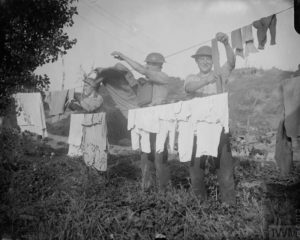Saturday March 9th, 1918
No Parades. Raining hard in morning. Work making firing range. Washing clothes. Afternoon, fried eggs for tea.
Firing Ranges
According to the ‘Musketry Regulations, Part II’¹, there were four types of rifle ranges:
- Classification – with facilities for long range, at least 800 yards. ‘As a general rule a site on level dry ground is the best.’;
- 30 Yards – for service cartridges. Particularly handy for new recruits ‘to overcome common faults such as flinching from the recoil, snatching at the trigger, &c.’
- Field Practice – for simulations of battles. These were for individual field practice, fire direction practice, and collective field practice. The latter was further divided into:
- ‘exercises for half-companies and sections in fire direction and application of collective fire;
- standard tests of collective grouping and fire effect;
- comparative demonstrations of fire effect and vulnerability;
- and exercises for companies designed to reproduce service conditions as far as possible and to illustrate tactical principles’.
- Miniature – for use with .220 ammunition only. These were unlikely to be a focus in war-time – as used as much by School Rifle Clubs etc as the Army.
It is unclear which of these ranges Frank was working on. However, the construction, maintenance and supervision was under the Royal Engineers. The Regulations also note that: ‘When considered necessary, troops using the range will be detailed to assist the Range Wardens in minor repairs to butts and firing points, such work will be performed without claim to pay’.
Washing clothes

Frank arrived in Marseilles over three months ago. This is the first time he mentions washing his clothes…
When coming off the front line, clothes and bedding were routinely fumigated to eliminate lice infestation.
However the washing of underwear and shirts was more mundane. Officers had their own orderlies (or batmen) to do this for them. Other ranks were on their own, as illustrated in this photograph of two soldiers hanging out their washing near the Ypres-Comines Canal in September 1917.
13th (Service) Battalion War Diary – 9th March 1918 – No 1 Sector, Olasli
Training as per programme.
References & Further Reading
¹ ‘Musketry Regulations, Part II Rifle Ranges & Musketry Appliances, 1910‘, HMSO, 1910
* Photograph Q6013 from the Imperial War Museum


